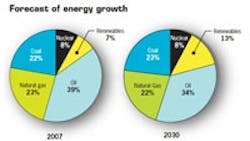Energy Myths
Energy companies are doing their bit
A common misperception is that energy companies have no intention of investing in clean energy and therefore government programs must do the heavy lifting. In fact, U.S. based oil and gas companies have spent over $121 billion from 2000 through 2007 on new energy technologies in the North American market, says the Energy Information Administration. Almost $104 billion of that went for carbon-based alternatives to petroleum, such as oil sands and waste residues. And nearly $16 billion went for efficiency improvements (cogeneration) and advanced-technology vehicles including electric cars.
In all, oil and gas firms ponied up almost 70% of all funds U.S. companies invested in new energy sources and 35% of all the money spent developing and researching electric vehicles.
Will renewables replace conventional energy sources? Don’t hold your breath
Coal, oil, natural gas will provide 79% of the energy in the U.S. in 2030, according to the Energy Information Administration. That would be a relatively small change from the 84% of U.S. energy these sources were responsible for in 2007. So as energy use climbs 0.4% annually over the next 20 years, renewable contribution of overall energy use will climb 0.2% annually despite years of government subsidies, state-level mandates, and the Green movements love of the technology.
Higher CAFE numbers = More gas burned
A classic tale of unintended consequences
Make sure cars get more miles to the gallon of gas, by CAFE standards and government coercion if necessary, and we’re bound to cut the country’s energy use, right? Wrong. At least it’s never worked that way yet. Every time mileage improves, Americans seem to respond by using their cars for more trips and increasing the length of those trips, taking advantage of the lower cost-per-mile of driving.
Jerry Taylor and Peter Van Doren of the Cato Institute give one explanation: “Energy efficient appliances reduce the costs of operation. This might not be a big deal when it comes to, say, the television set (we won’t watch more TV just because it costs a little less to turn on the set). But for appliances like air conditioners, it makes all the difference during peak demand periods. Energy efficiency reduces the marginal cost of energy services and thus increases -- not decreases -- energy consumption. This is a well-known phenomenon called the ‘rebound effect.’ The same goes for automobile fuel efficiency. Environmentalists argue that increasing the miles per gallon of the cars we drive would save more energy than increased drilling could produce. But the data show that fuel consumption goes up whenever automobile fuel efficiency goes up. Nearly all the gains in fuel efficiency disappear once we account for the demonstrable increases in driving that such investments produce.”
